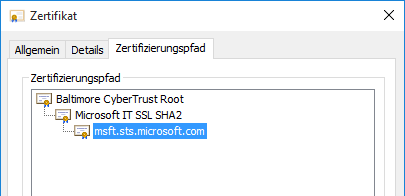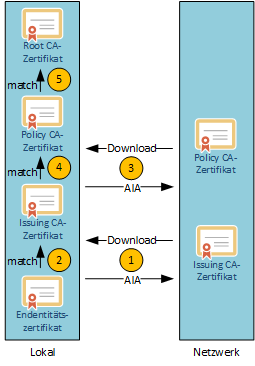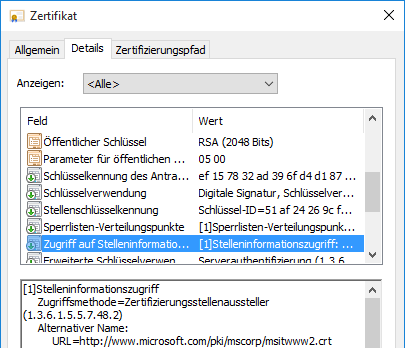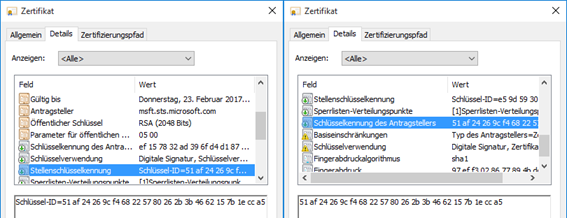In order to determine whether a certificate has been issued by a certification authority that has been classified as trustworthy, a trust chain must be formed. To do this, all certificates in the chain must be determined and checked. Microsoft CryptoAPI builds all possible certificate chains and returns those with the highest quality to the requesting application.

To better illustrate how this works, the following example explains the process of locating certificates using a three-level PKI hierarchy.

- For the end-entity certificate to be verified, the download path for the CA certificate of the issuing CA is determined from the Authority Information Access (AIA) field. This is then downloaded and saved locally.
- The end entity certificate is now assigned to the CA certificate of the issuing CA (see the following paragraph), which must now be verified next.
- For the issuing CA certificate to be verified, the download path for the certificate of the issuing certification authority (the policy CA) is determined from its AIA field. This is then downloaded and saved locally.
- The CA certificate of the issuing CA is now mapped to the CA certificate of the policy CA, which must now be verified next.
- The issuing certification authority (the root CA) is determined for the policy CA certificate to be verified. This certificate must be in the local list of trusted root CAs to be recognized as valid. Even though the AIA field of the issuing CA's certificate points to the root CA, and thus the client would theoretically be able to download and store it, a client would still consider the certificate untrusted unless the root CA certificate was previously stored in local storage by a system administrator. Without this behavior, there would be no control over which CA certificates should be trusted and which should not.

Do you know TameMyCerts? TameMyCerts is an add-on for the Microsoft certification authority (Active Directory Certificate Services). It extends the function of the certification authority and enables the Application of regulationsto realize the secure automation of certificate issuance. TameMyCerts is unique in the Microsoft ecosystem, has already proven itself in countless companies around the world and is available under a free license. It can downloaded via GitHub and can be used free of charge. Professional maintenance is also offered.
A certificate is assigned to its certification authority by comparing certain attributes within both certificates. There are three possibilities here, depending on which attributes are contained in the certificates:
- Exact Match. If the end entity certificate contains a Authority Key Identifier (AKI) certificate extension, this is compared with the value of the Subject Key Identifier (SKI) certificate extension of the certificate of the issuing certification authority. In addition, the Issuer Distinguished Name of the certificate is compared with the applicant. Subject Distinguished Name) of the certificate of the issuing certification body.
- Key Match. If the end entity certificate contains a Authority Key Identifier (AKI) certificate extension, this is compared with the value of the Subject Key Identifier (SKI) certificate extension of the certificate of the issuing certification authority.
- Name Match. The issuer (Issuer Distinguished Name) of the certificate is matched with the applicant (Applicant Distinguished Name). Subject Distinguished Name) of the certificate of the issuing certification authority. The comparison of Subject DN and Issuer DN is not carried out as a character string comparison, but as a binary comparison.

5 thoughts on “Grundlagen: Auffinden von Zertifikaten und Validierung des Zertifizierungspfades”
Comments are closed.